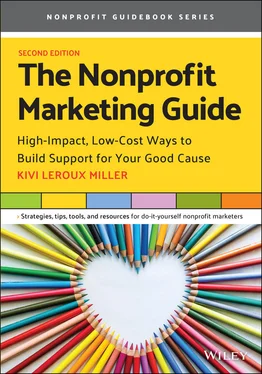My hunch that staff at thousands of nonprofits were in the exact same situation that my clients and I had been in for many years was right: they too were communications departments of just one or two people who had to do it all themselves and didn't know where to turn for help. The response to Nonprofit Marketing Guide the company was so positive that I knew it was time to write an eponymous book, which was published in 2010.
The nonprofit communications profession has continued to evolve in leaps and bounds since then. I was pleasantly surprised to see many college and university certificate and degree programs begin teaching about marketing in the nonprofit sector, assigning this book as required reading. I was especially tickled one day in 2016 when one of my best friends from high school posted a photo of her daughter's college textbook on Facebook – and it was this book!
Throughout 2010–2020, I too was studying nonprofit communications and marketing in earnest. At Nonprofit Marketing Guide, we launched an annual Nonprofit Communications Trends Report sharing the results of survey data from thousands of nonprofits. We also launched a number of training, coaching, and mentoring programs for nonprofit communications staff that allowed me to see the inner workings of hundreds of nonprofits. Over the years, we studied not only the communications tactics nonprofits use, but how the required skill set is changing, the challenges staff in the job face each day, and what communications effectiveness looks like in the nonprofit sector.
I shared what we continued to learn in two additional books, the award-winning Content Marketing for Nonprofit: A Communications Map for Engaging Your Community, Becoming a Favorite Cause, and Raising More Money (Jossey-Bass, 2013) and CALM not BUSY: How to Manage Your Nonprofit's Communications for Great Results (Bold & Bright Media, 2018).
I think of those books as the 201 and 301 texts for nonprofit communicators. As 2020 and another new decade approached, I knew it was time to revisit the 101 book. I've updated The Nonprofit Marketing Guide for a new generation of communications professionals and career changers getting started in the sector.
While these new members of our profession are on my mind as I write and edit this edition, I am also surrounded in spirit by literally thousands of generous souls who have helped me learn every lesson that I am sharing in this book. It is truly a collective effort, and for each and every interaction and conversation that culminated into the thinking and experiences shared on these pages, I am eternally grateful.
Kivi Leroux Miller
September 2020
INTRODUCTION: HOW TO USE THIS BOOK
This book is meant to be part real-world survival guide and part nitty-gritty how-to handbook for busy nonprofit marketers with small budgets and staff, including executive directors who are asked to do it all, and anyone new to the work of nonprofit marketing and communications. I hope it is both a reference that you'll return to often and a comforting support, reassuring you that you really can do this, even if you are working on your own. Crease up the spine, mark up the pages, and make it your own personal guide to marketing your good cause.
The book is organized into four sections.
Part One: Getting Ready to Do It Right gives you some big-picture perspective on the world of nonprofit marketing and provides context for everything else that follows in the book. It includes chapters on planning, effectiveness, listening, and more.
Part Two: Answering the Three Most Important Nonprofit Marketing Questions dives into defining your target communities, creating messaging that works, and delivering those messages in the best ways.
Part Three: Building a Community of Supporters Around You recognizes the profound shift in how people and nonprofits are connecting with and relating to each other and will help you build your own community of supporters.
Part Four: Doing It Yourself Without Doing Yourself In looks at the trio of elements required for successful implementation of any marketing program: time, talent, and treasure.
The book concludes with some suggestions for the big questions to ask yourself as you evaluate the success of your nonprofit marketing program.
You can approach the book in the way that works best for you: read it straight through, or backward, or start in the middle. The detailed table of contents in the front, as well as an index in the back, can help you quickly find the sections you need.
To continue the learning and conversation, we invite you to join us at NonprofitMarketingGuide.comand to follow us on social media. Look for @npmktgdand @kivilm. You will also find a companion workbook to help you implement what you learn in the book at npmg.us/workbook.
PART ONE Getting Ready to Do It Right
Nonprofit marketing is hard work. It's also tremendously fun and satisfying, especially when you do it right. Your work will challenge you in ways you have yet to understand, and you'll learn about disciplines that you had never considered before. Because nonprofit marketing is complex, it can quickly overwhelm people new to the field. This is particularly true if it's something thrown on top of your “real” job as an executive director, development director, or program manager. This book should make your job a little easier.
In Chapter 1, I review 10 realities of marketing and communications work that are the foundation for the thinking in the rest of the book. Chapter 2defines nonprofit marketing and the many choices you have for marketing goals, strategies, objectives, and tactics as a nonprofit communicator. Chapter 3gives you an overview of what a full-blown marketing strategy looks like, what tactical communications plans include, and how to do a quick-and-dirty version if that is all you can handle.
Chapter 4outlines the different stages or levels of effectiveness that nonprofits move through as their communications staff become more skilled and their organizations fully embrace marketing best practices. The final chapter in this section, Chapter 5, explains why listening (call it market research if you prefer) is essential to any successful nonprofit marketing strategy and how you can use a variety of tools and methods to learn a great deal about the people you are working with and serving.
chapter ONE 10 Realities of Nonprofit Marketing
I opened the first edition of this book with a chapter called “10 New Realities for Nonprofits” with an emphasis on “New.” Back in 2010, I was still urging nonprofits to be OK with calling this work “marketing” rather than euphemisms like “outreach,” to take social media seriously, and to convince them that people over 50 really were using the Internet. Thankfully, we've moved well beyond those sticking points.
All of the other elements in that original list proved foundational to the work of nonprofit communications. While I have updated this list, what you'll find here are the assumptions on which all of the other chapters in the book are built. Understanding this list will help you get the most out of this book and to understand the choices I suggest you make.
Many forces beyond your control will affect how you market your nonprofit organization. The economy will go up and down. Friendly elected officials will be in charge, and then they will lose an election. Talented volunteers, staff, and board members will come and go. What people can do from their phones no matter where they are in the world will continue to grow.
But I don't expect the following 10 realities to change much.
Читать дальше












